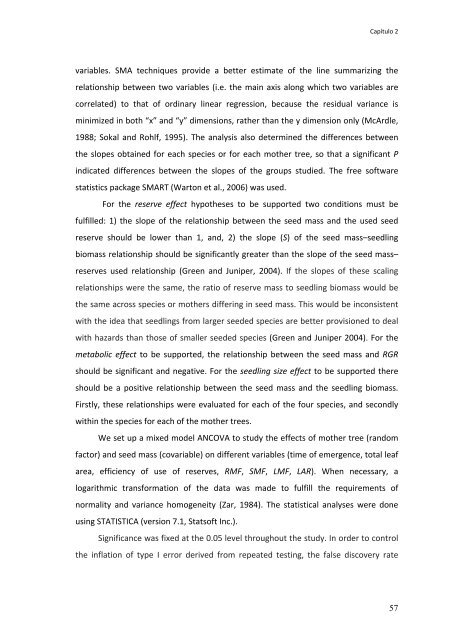Establecimiento de cuatro especies de Quercus en el sur de la ...
Establecimiento de cuatro especies de Quercus en el sur de la ...
Establecimiento de cuatro especies de Quercus en el sur de la ...
Create successful ePaper yourself
Turn your PDF publications into a flip-book with our unique Google optimized e-Paper software.
Capítulo 2<br />
variables. SMA techniques provi<strong>de</strong> a better estimate of the line summarizing the<br />
r<strong>el</strong>ationship betwe<strong>en</strong> two variables (i.e. the main axis along which two variables are<br />
corr<strong>el</strong>ated) to that of ordinary linear regression, because the residual variance is<br />
minimized in both “x” and “y” dim<strong>en</strong>sions, rather than the y dim<strong>en</strong>sion only (McArdle,<br />
1988; Sokal and Rohlf, 1995). The analysis also <strong>de</strong>termined the differ<strong>en</strong>ces betwe<strong>en</strong><br />
the slopes obtained for each species or for each mother tree, so that a significant P<br />
indicated differ<strong>en</strong>ces betwe<strong>en</strong> the slopes of the groups studied. The free software<br />
statistics package SMART (Warton et al., 2006) was used.<br />
For the reserve effect hypotheses to be supported two conditions must be<br />
fulfilled: 1) the slope of the r<strong>el</strong>ationship betwe<strong>en</strong> the seed mass and the used seed<br />
reserve should be lower than 1, and, 2) the slope (S) of the seed mass–seedling<br />
biomass r<strong>el</strong>ationship should be significantly greater than the slope of the seed mass–<br />
reserves used r<strong>el</strong>ationship (Gre<strong>en</strong> and Juniper, 2004). If the slopes of these scaling<br />
r<strong>el</strong>ationships were the same, the ratio of reserve mass to seedling biomass would be<br />
the same across species or mothers differing in seed mass. This would be inconsist<strong>en</strong>t<br />
with the i<strong>de</strong>a that seedlings from <strong>la</strong>rger see<strong>de</strong>d species are better provisioned to <strong>de</strong>al<br />
with hazards than those of smaller see<strong>de</strong>d species (Gre<strong>en</strong> and Juniper 2004). For the<br />
metabolic effect to be supported, the r<strong>el</strong>ationship betwe<strong>en</strong> the seed mass and RGR<br />
should be significant and negative. For the seedling size effect to be supported there<br />
should be a positive r<strong>el</strong>ationship betwe<strong>en</strong> the seed mass and the seedling biomass.<br />
Firstly, these r<strong>el</strong>ationships were evaluated for each of the four species, and secondly<br />
within the species for each of the mother trees.<br />
We set up a mixed mo<strong>de</strong>l ANCOVA to study the effects of mother tree (random<br />
factor) and seed mass (covariable) on differ<strong>en</strong>t variables (time of emerg<strong>en</strong>ce, total leaf<br />
area, effici<strong>en</strong>cy of use of reserves, RMF, SMF, LMF, LAR). Wh<strong>en</strong> necessary, a<br />
logarithmic transformation of the data was ma<strong>de</strong> to fulfill the requirem<strong>en</strong>ts of<br />
normality and variance homog<strong>en</strong>eity (Zar, 1984). The statistical analyses were done<br />
using STATISTICA (version 7.1, Statsoft Inc.).<br />
Significance was fixed at the 0.05 lev<strong>el</strong> throughout the study. In or<strong>de</strong>r to control<br />
the inf<strong>la</strong>tion of type I error <strong>de</strong>rived from repeated testing, the false discovery rate<br />
57

















